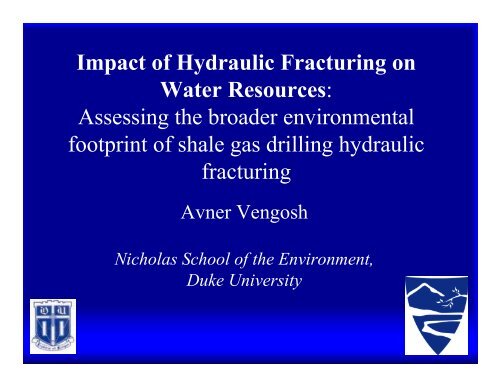Impact of Hydraulic Fracturing on Water Resources: Assessing the ...
Impact of Hydraulic Fracturing on Water Resources: Assessing the ...
Impact of Hydraulic Fracturing on Water Resources: Assessing the ...
You also want an ePaper? Increase the reach of your titles
YUMPU automatically turns print PDFs into web optimized ePapers that Google loves.
<str<strong>on</strong>g>Impact</str<strong>on</strong>g> <str<strong>on</strong>g>of</str<strong>on</strong>g> <str<strong>on</strong>g>Hydraulic</str<strong>on</strong>g> <str<strong>on</strong>g>Fracturing</str<strong>on</strong>g> <strong>on</strong><br />
<strong>Water</strong> <strong>Resources</strong>:<br />
<strong>Assessing</strong> <strong>the</strong> broader envir<strong>on</strong>mental<br />
footprint <str<strong>on</strong>g>of</str<strong>on</strong>g> shale gas drilling hydraulic<br />
fracturing<br />
Avner Vengosh<br />
icholas School <str<strong>on</strong>g>of</str<strong>on</strong>g> <strong>the</strong> Envir<strong>on</strong>ment,<br />
Duke University
The critical role <str<strong>on</strong>g>of</str<strong>on</strong>g> shale gas producti<strong>on</strong><br />
in <strong>the</strong> U.S.<br />
0.5<br />
Total gas producti<strong>on</strong> in U.S.<br />
800<br />
Fracti<strong>on</strong> <str<strong>on</strong>g>of</str<strong>on</strong>g> shale gas out <str<strong>on</strong>g>of</str<strong>on</strong>g><br />
total gas producti<strong>on</strong><br />
700<br />
0.4<br />
600<br />
500<br />
0.3<br />
400<br />
0.2<br />
20%<br />
Gas producti<strong>on</strong> (billi<strong>on</strong> cubic meter)<br />
300<br />
200<br />
0.1<br />
Shale gas<br />
138<br />
100<br />
0<br />
0<br />
1990 2000 2010 2020 2030 2040<br />
Year
The Marcellus Shale, Appalachian Basin
Map <str<strong>on</strong>g>of</str<strong>on</strong>g> The Marcellus (red) and n<strong>on</strong>e-Marcellus (blue)<br />
wells drilled in Pennsylvania in 2010<br />
(PA DEP)<br />
Map<br />
In 2010 1,386 gas and oil wells were drilled in PA
M<strong>on</strong>trose, Susquehanna, Pennsylvania<br />
(June, 2011)
What is hydraulic fracturing (fracking)?
Major stages in shale gas producti<strong>on</strong>:<br />
• Pad, Impoundment and Road C<strong>on</strong>structi<strong>on</strong>; heavy truck traffic and<br />
heavy equipment;<br />
• Drilling – Drilling rigs require power from diesel engines;<br />
• <str<strong>on</strong>g>Fracturing</str<strong>on</strong>g> – During this stage, large amounts <str<strong>on</strong>g>of</str<strong>on</strong>g> water and fracturing<br />
fluid are pumped into <strong>the</strong> well to create fractures for <strong>the</strong> gas to escape<br />
from <strong>the</strong> shale;<br />
• A porti<strong>on</strong> <str<strong>on</strong>g>of</str<strong>on</strong>g> <strong>the</strong> fluid (flowback) is returned into a wastewater<br />
impoundment where it is trucked for disposal/ treatment; <strong>on</strong>ce <strong>the</strong> well<br />
in operati<strong>on</strong> – generati<strong>on</strong> <str<strong>on</strong>g>of</str<strong>on</strong>g> produced water;<br />
(from PA_DEP report <strong>on</strong> potential gas emissi<strong>on</strong>)
Major stages in shale gas producti<strong>on</strong>:<br />
• Flaring –testing <strong>the</strong> gas well before producti<strong>on</strong>. Emissi<strong>on</strong>s are<br />
created from <strong>the</strong> burning <str<strong>on</strong>g>of</str<strong>on</strong>g> gas and atmospheric venting <str<strong>on</strong>g>of</str<strong>on</strong>g> n<strong>on</strong>combusted<br />
gas;<br />
• C<strong>on</strong>densate Tanks – Gas pumped from <strong>the</strong> well may c<strong>on</strong>tain brine<br />
and o<strong>the</strong>r volatile organic compounds that c<strong>on</strong>dense into collecti<strong>on</strong><br />
tanks;<br />
• Compressor stati<strong>on</strong>s – Raw gas is piped from wells to compressor<br />
stati<strong>on</strong>s where <strong>the</strong> gas is pre-treated and compressed.<br />
(from PA_DEP report <strong>on</strong> potential gas emissi<strong>on</strong>)
Key envir<strong>on</strong>mental risks associated with shale<br />
gas drilling and hydro-fracturing<br />
Methane<br />
c<strong>on</strong>taminati<strong>on</strong> <str<strong>on</strong>g>of</str<strong>on</strong>g><br />
drinking water<br />
wells<br />
Fugitive emissi<strong>on</strong>s<br />
<str<strong>on</strong>g>of</str<strong>on</strong>g> methane to <strong>the</strong><br />
atmosphere<br />
<strong>Water</strong> use<br />
(3-6 milli<strong>on</strong><br />
gall<strong>on</strong> per well)<br />
C<strong>on</strong>taminati<strong>on</strong> by<br />
fracturing fluid<br />
(transportati<strong>on</strong>, spills,<br />
disposal)<br />
Disposal <str<strong>on</strong>g>of</str<strong>on</strong>g><br />
fracturing<br />
fluids/produced<br />
water<br />
Air polluti<strong>on</strong> associated<br />
with different stages <str<strong>on</strong>g>of</str<strong>on</strong>g><br />
gas producti<strong>on</strong><br />
Health implicati<strong>on</strong>s,<br />
quality <str<strong>on</strong>g>of</str<strong>on</strong>g> life<br />
(traffic, noise)
The research methods:<br />
Duke Research activities (updated to August 2011):<br />
1.Sampling ~200 shallow private wells in eastern PA, NY;<br />
2. Sampling produced waters from several gas wells in PA and<br />
NY;<br />
3. Analysis <str<strong>on</strong>g>of</str<strong>on</strong>g> methane in private wells – c<strong>on</strong>centrati<strong>on</strong>s, isotopes<br />
4. Analysis <str<strong>on</strong>g>of</str<strong>on</strong>g> <strong>the</strong> chemistry and isotopes <str<strong>on</strong>g>of</str<strong>on</strong>g> groundwater<br />
associated and not associated with gas wells in PA.<br />
5. Analysis <str<strong>on</strong>g>of</str<strong>on</strong>g> <strong>the</strong> Marcellus Shale brines<br />
3. Chemical (major and trace elements) and isotopic ( 87 Sr/ 86 Sr,<br />
11<br />
B/ 10 B, 18 O/ 16 O, 2 H/H) measurements.
Proceedings <str<strong>on</strong>g>of</str<strong>on</strong>g> nati<strong>on</strong>al<br />
Academy <str<strong>on</strong>g>of</str<strong>on</strong>g> Sciences,<br />
May 17, 2011
Duke research in Pennsylvania and ew York
Hydro-geological cross secti<strong>on</strong>
Definiti<strong>on</strong> <str<strong>on</strong>g>of</str<strong>on</strong>g> active versus n<strong>on</strong>-active wells:<br />
Private wells located
Isotopic fingerprinting <str<strong>on</strong>g>of</str<strong>on</strong>g> methane source<br />
δ 13 C – 13 C/ 12 C<br />
CH 4<br />
δ 2 H – 2 H/H
Methane source?<br />
N<strong>on</strong>-active<br />
Active<br />
A distincti<strong>on</strong> between active<br />
wells with <strong>the</strong>rmogenic<br />
isotopic fingerprint and n<strong>on</strong>active<br />
wells with a mixed<br />
compositi<strong>on</strong><br />
N<strong>on</strong>-active<br />
Active
o apparent chemical c<strong>on</strong>taminati<strong>on</strong>: no differences between<br />
active to n<strong>on</strong> active wells
Results <str<strong>on</strong>g>of</str<strong>on</strong>g> <strong>the</strong> study indicate:<br />
1. High methane c<strong>on</strong>centrati<strong>on</strong> in active wells (1 km had lower methane and different<br />
compositi<strong>on</strong>;<br />
2. Active wells were not c<strong>on</strong>taminated by chemicals derived<br />
from c<strong>on</strong>taminati<strong>on</strong> <str<strong>on</strong>g>of</str<strong>on</strong>g> produced waters.
The toxicity <str<strong>on</strong>g>of</str<strong>on</strong>g> produced water
How much produced water is generated in<br />
shale gas wells?<br />
• It is estimated that for every milli<strong>on</strong> cubic feet <str<strong>on</strong>g>of</str<strong>on</strong>g> gas 5 to<br />
20 barrels ( 28-112 cubic feet) <str<strong>on</strong>g>of</str<strong>on</strong>g> wastewater is generated.<br />
• In 2010 <strong>the</strong> US produced 4.87 trilli<strong>on</strong> cubic feet (data from<br />
IEA) which would equivalent to 136 to 545 milli<strong>on</strong> cubic<br />
feet (about 1 to 4 billi<strong>on</strong> gall<strong>on</strong>) <str<strong>on</strong>g>of</str<strong>on</strong>g> produced water<br />
generated for 2010.
What’s in produced water?<br />
• Salinity (Marcellus brine – 250,000 mg/L (10 fold<br />
seawater);<br />
• High bromide, even in diluted brine would enhance <strong>the</strong><br />
formati<strong>on</strong> <str<strong>on</strong>g>of</str<strong>on</strong>g> carcinogenic disinfecti<strong>on</strong> by-products (e.g.,<br />
trihalomethane) up<strong>on</strong> chlorinati<strong>on</strong> <str<strong>on</strong>g>of</str<strong>on</strong>g> downstream potable<br />
water;<br />
• High c<strong>on</strong>centrati<strong>on</strong>s <str<strong>on</strong>g>of</str<strong>on</strong>g> toxic elements (arsenic, selenium,<br />
lead);<br />
• High c<strong>on</strong>centrati<strong>on</strong>s <str<strong>on</strong>g>of</str<strong>on</strong>g> naturally occurring radioactive<br />
materials (NORMs)
What’s in produced water?<br />
Marcellus produced water<br />
226<br />
Ra = 5000 pico-curie per liter<br />
The<br />
Laboratory for<br />
Envir<strong>on</strong>menta<br />
l Analysis <str<strong>on</strong>g>of</str<strong>on</strong>g><br />
RadioNuclide<br />
s (LEARN)<br />
Duke<br />
University<br />
(drinking water standard =<br />
5 pico-curie per liter
Research in orth Carolina<br />
1. Work with DENR and USGS (and o<strong>the</strong>rs) to establish a robust<br />
and systematic baseline for <strong>the</strong> quality <str<strong>on</strong>g>of</str<strong>on</strong>g> groundwater in areas<br />
that are expected to be drilled for shale gas in Lee and<br />
Chatham counties.<br />
1. Characterize <strong>the</strong> compositi<strong>on</strong> <str<strong>on</strong>g>of</str<strong>on</strong>g> formati<strong>on</strong> water in shale gas<br />
in NC.<br />
1. Use <strong>the</strong> water quality and isotopic fingerprints for a<br />
m<strong>on</strong>itoring system following shale gas drilling and hydr<str<strong>on</strong>g>of</str<strong>on</strong>g>racking.
Can deep gas and brine in nor<strong>the</strong>astern PA flow<br />
to <strong>the</strong> surface? Is it related to fracking ?<br />
Deep water displacement



